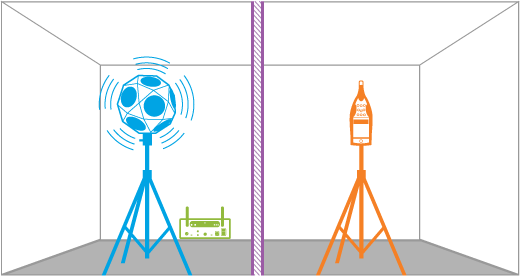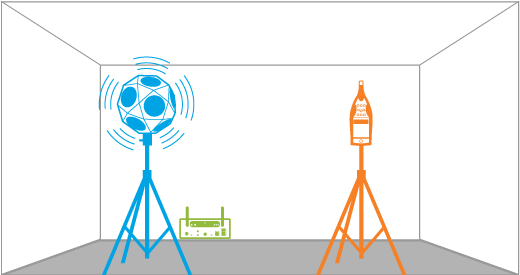
Room and building acoustics
Architectural acoustics encompasses the fields of building acoustics and room acoustics. Building acoustics focuses on sound transmission through walls, doors and floors. Room acoustics focuses on the behaviour of sound inside a room
For many buildings, such as classrooms, offices, theatres, and concert halls, their acoustic properties are critical to their ability to perform their primary function.
Building acoustics
To prevent noise from entering into a room or to understand the degree to which it penetrates, you can evaluate the building’s acoustics. Building acoustics focuses on sound transmission through walls and entrances, such as footfalls from people walking above or vehicles driving below. For these, you need to measure the sound both inside and out, and to correct the difference for reverberation and background noise in the receiving room. With information about the noise, such as frequency content, mitigation can be effectively targeted – such as with insulation and shielding.
Room acoustics
In a room, good acoustics require a design that is fit for purpose, such as easy communication and a high degree of intelligibility in office spaces or long reverberation times in concert halls. Issues with acoustics are normally caused by sound being reflected too much, too little or in the wrong direction. To assess this, you can analyze the room’s acoustic properties, such as reverberation time – the length of time that sound echoes for – or its impulse response, which enables the acoustic characteristics of a space to be captured. With a better picture of the sound’s behavior in the room, you can improve it with redesigns or absorptive materials.
Building acoustics is the assessment of sound insulation in buildings and building elements, and building acoustics measurements are invaluable when designing or examining noise control constructions in the built environment.
Whether in our homes, at work, or at leisure, our lives are constantly affected by an ever-increasing number of noise sources such as televisions, kitchen appliances, neighbours, traffic, industry – all of it noise pollution. One method of reducing the pollution is to reduce the noise source level. Building acoustics takes another approach and examines insulation and isolation from the source.
Brüel & Kjær has a complete programme of applications to check conformance to building regulations and pinpoint weak spots in sound insulation.
System suggestion
Building Acoustics Software BZ-7228 is available for Types 2250 and 2270 sound level meters, providing flexibility, ease of use and confidence in your results that field measurements require in building acoustics.
Back at the office, Qualifier Type 7830 offers versatile post-processing and reporting of your measurement results.
A typical configuration for building acoustics measurements would consist of a sound source or tapping machine, a sound level meter, and PC for reporting.
> Building Acoustic Measurement on 2270 Hand-held Analyzer (YouTube)
The way sound is created, propagated, perceived, measured and modelled inside an enclosed space is called room acoustics. Enclosed spaces include dwellings, offices, workshops, factory halls, lecture rooms, auditoriums, concert halls and transportation terminals.
Acoustic measurements are used to validate new constructions and troubleshoot existing ones. Reverberation time is the single most important parameter used to describe room acoustics, but parameters describing music quality and speech intelligibility are also important.
System suggestion
BZ-7227 Reverberation Time Software for Types 2250 and 2270 sound level meters supports both impulsive excitation (Schroeder’s method), with pistol shots or balloon bursts, and the interrupted noise method, using a loudspeaker. Measurements comply with the relevant parts of ISO standards including ISO 140, ISO 3382 (room acoustics) and ISO 354.
DIRAC Room Acoustics Software Type 7841 is used for measuring room acoustic parameters in the field or laboratory according to ISO 3382 and ISO 18233 (application of measurement methods). In combination with DIRAC, Echo Speech Source Type 4720 performs speech intelligibility measurements in accordance with IEC 60268-16, quickly and easily.
> DIRAC 6 Open Plan Office Measurements (YouTube)

Iscriviti alla nostra Newsletter e ricevi le informazioni più recenti dal mondo del suoni e delle vibrazioni


